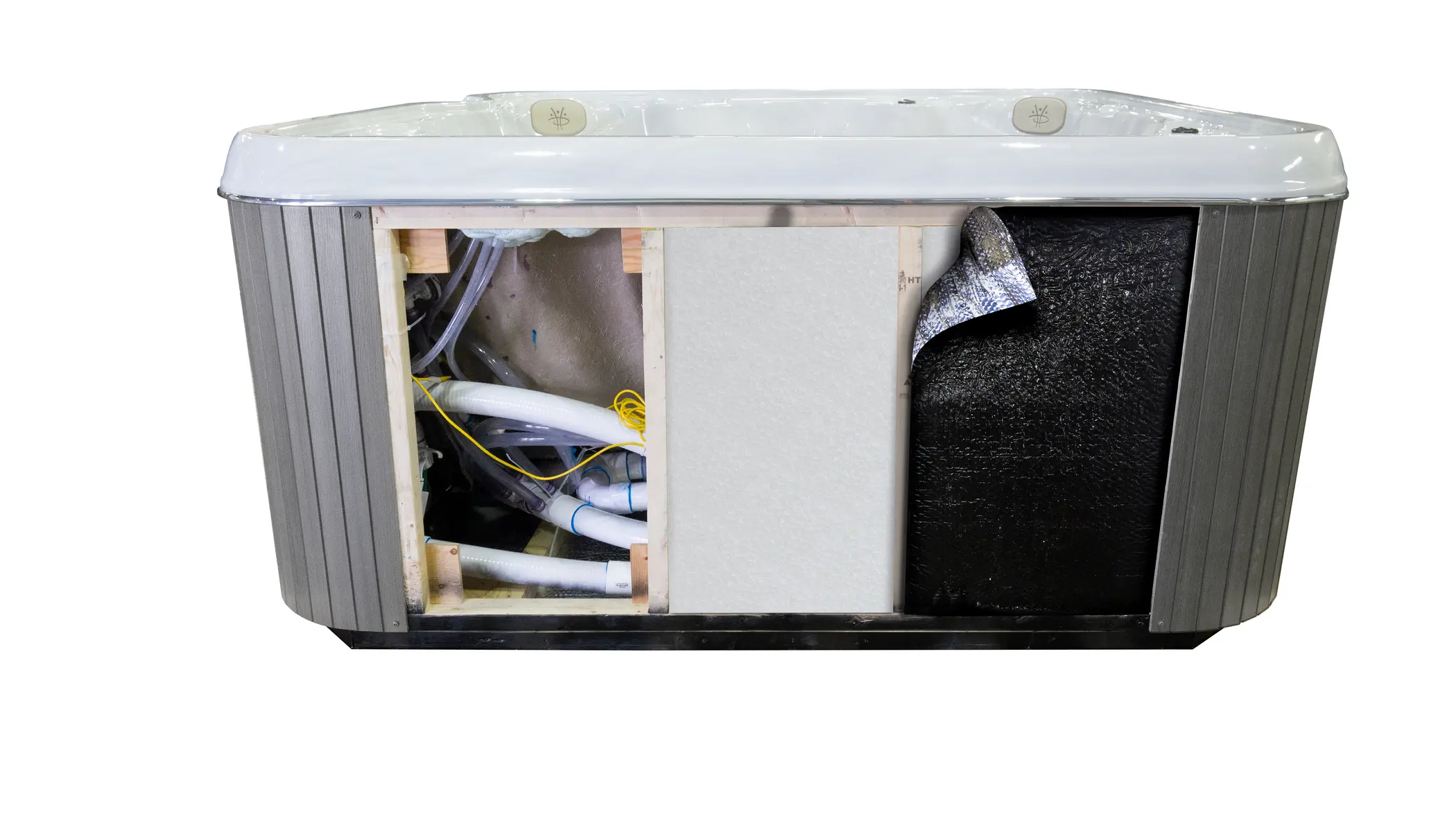How Much Does it Really Cost Each Month to Run a Hot Tub in Canada?
If you’re in the market for a hot tub, there’s a good chance you’re considering all the factors that will determine what owning one will actually cost you on a regular basis. After you figure out the initial spend on the tub, you’re likely asking, “how much will a hot tub actually cost me each month?”
At Hydropool, we want our customers to know everything they need to before they buy, which is why we wrote this article: to break down the ongoing operating costs of our hot tubs.
In Canada in 2025, you can expect to pay about $60 a month in ongoing costs to run a hot tub. That includes both power and cleaning. We’re going to break the cost down throughout this article, but we wanted you to know up front that’s the average monthly spend.
It’s important to note: This is an average. There are many factors that come into play here, which we will go over in this article. Let’s break this down into what costs what for a better picture of your ongoing expenses once you’ve got the hot tub in place.

How Will a Hot Tub Affect My Electricity Bill?
A hot tub will affect your electricity bill. Like putting gas in a car (or electricity!), hot tubs require power. Here’s how much the average hot tub electrical bill increases in Canada: About $30 a month.
That’s the average. A monthly hot tub electrical bill from sunny Medicine Hat is going to be different than the winter in Quebec City. Our best advice here is to speak to a local retailer for guidance on what it costs in your area and use our numbers here as a guideline.
That’s because “How much will my electricity bill be affected” is one of those “but it depends” questions that keep coming up with hot tubs. Here are some of the factors that can impact your electricity bill:
- Where you live and the temperatures there
- How the tub is built and especially how it is insulated
- How often you use the tub and for how long. These are actually the two most significant factors that decide ongoing costs, wherever you live. As with your washing machine or driving car, the more you use it, the more it costs.
- Whether you need to run the heat all summer or can turn it down
- How often the cover is off the tub in any season, and the quality of that cover
- What size of the hot tub is and the power accessories that go with it
- Your local power costs
A good local retailer can help you determine your likely month-to-month electrical costs.
The Crucial Role Insulation Plays in Hot Tub Running Costs
You can’t control all the factors that influence ongoing costs, obviously. Some only come into play after you buy a hot tub.
When you buy a hot tub, one of the major things to understand is how the hot tub is insulated.
A few of the manufacturers that place a premium on insulation include Arctic, Watkins/HotSprings, Bullfrog, MasterSpas, Jacuzzi, Dream Maker, Nordic Hot Tubs and Hydropool.
Insulation is a key point of differentiation for hot tub manufacturers. While everyone has the same goals in mind, each does this part differently, sometimes slightly, sometimes substantially.
The purpose is the same, however you do it. Insulation plays a key role in keeping your tub at a consistent temperature and ensuring your motor doesn’t have to do all the work – which helps keep your costs down.
You need enough insulation to stop heat from transferring out of your tub. You also need insulation in the right places to make the best use of the heat generated by your tub so that it works efficiently.
Sometimes more isn’t always better. What you need is enough insulation.
What does that mean? For example, your house isn’t entirely filled with insulation. If built to proper code, its walls and attic are filled with enough insulation to help contain the air at the comfortable temperature you seek.
At a certain point, adding more doesn’t help. It can’t trap the air in any more effectively and all you’re doing is increasing costs. Your oven works in a similar way. So does your fridge or anything that must maintain a set temperature. If adding more insulation fixed everything, rich people would have fridges with massive sides filled with foam. But they don’t, because there’s no need for them.
Hot tubs work in a similar fashion. They require sufficient insulation to stop heat transfer as much as possible, in order to trap it in place and help the hot tub stay warm without using more power.

The insides of your hot tub matter as much as the outside! Insulation is one of the key factors in keeping energy bills as low as possible when you buy a hot tub. The version above is from Hydropool’s Serenity collection.
What is the Average Monthly Chemical Spend for a Hot Tub?
Water that sits and isn’t replaced requires a bit of effort to maintain. We call water that doesn’t move bogs or sloughs or swamps or other such unattractive words.
But sitting water is ultimately what happens when you have a hot tub or a spa.
You could continually swap the water out of your hot tub like you do in a bathtub or keep a constant flow from a hose and drain it at the same rate, at the same time. But it’s not very practical to do that and your water costs would balloon. So hot tubs require water maintenance.
The cost of maintaining a tub in Canada is generally around $30. Some people buy things like vacuums to remove debris or a skimmer for ongoing cleaning, with a one-time cost of around $100.
Why Do Hot Tubs Need to be Cleaned at All?
Because everything loves warm water! When people get in the tub, chemicals like deodorant, perfume, and hairspray can get washed off bodies and into the tub. Organic matter such as dirt, leaves and bugs also can end up in there when the top is off. Algae is a plant that can grow in your tub, and fungi such as mold or mildew will also thrive in warm water conditions. All this stuff needs to get out of your tub one way or another. You clean your bathroom and kitchen sink regularly for many of the same reasons.
You require cleaning products for your tub, the same way you do for your dishes: sanitizers, buffer, ph adjusters, scale inhibitors are required maintenance.
Movement also helps your water stay fresh: Most tubs automatically circulate the water on a regular schedule (if you’ve ever been standing beside a tub and it just “comes on” this is why – it’s to engage the filters and promote cleaning).
What Is the Cost of Draining My Hot Tub?
You also need to drain and re-fill your hot tub at least every quarter. Water can take care of a lot on its own, but at some point it needs a little help to wipe everything out that’s in it.
Here’s a home test of what you can do to understand the issue. Let’s say you take a glass of water and put a tablespoon of sugar in it. Then another and another. Around the fourth one, it will be obvious: you won’t be able to stir it all in. It just won’t dissolve. At that point, the only way forward is to clean the water or replace it with new water. The same thing happens to your tub. If you let it go too long the water becomes saturated.
So regular water sanitation is required, which helps keep this from happening. And the easiest way to do that is by draining.
There’s a water cost to fill up your tub, and our average is about $30 a fill, which contributes to your average monthly cost. You will also want to use a purge product such as Ahh-some or Swirl-Away, and you should use it every time you drain your spa. Some people opt to pay someone to do this work for them, and the cost is usually around $300 each time.
We included this annual cost in our monthly average maintenance bill estimate: We just want you to know where your money is going!
How Do I Find Out About What My Hot Tub Costs Are Near Me?
Ongoing costs are part of owning any hot tub. We want our customers at Hydropool to understand what they will be paying for once they buy a tub and why, all before they make any purchase. Once you get your hot tub up and running, your expenses will include:
- ongoing power costs to run your tub’s heater and jets
- regular cleaning bills, which are needed due to changes that will happen to your water over time.
Overall monthly costs average around $60 in Canada. To get a more exact number for where you live, you’ll want to talk to someone in your immediate area, as we can only give an average here. Where you live will affect your monthly costs.
A local Hydropool retailer can help you answer questions about your specific situation. Find one closest to you here.





